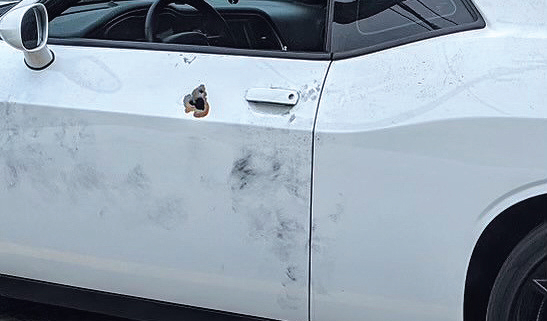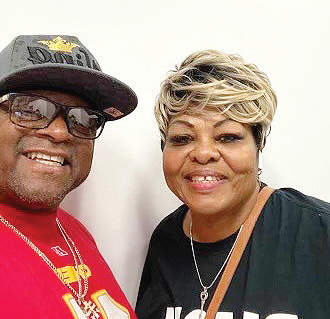 In 2018, the Memorial Hermann Red Duke Trauma Institute implemented
a new process which enables eligible
patients to be taken straight from the
Memorial Hermann Life Flight® helipad
to the trauma OR, bypassing the hospital’s
Emergency Center. This process, which
dramatically reduces the time to lifesaving,
definitive care, was instrumental in saving
the life of abdominal gunshot wound
patient Lavern “Vern” Smith.
In 2018, the Memorial Hermann Red Duke Trauma Institute implemented
a new process which enables eligible
patients to be taken straight from the
Memorial Hermann Life Flight® helipad
to the trauma OR, bypassing the hospital’s
Emergency Center. This process, which
dramatically reduces the time to lifesaving,
definitive care, was instrumental in saving
the life of abdominal gunshot wound
patient Lavern “Vern” Smith.
It was a Friday afternoon in March of 2020, and Smith, who provided sanitation services to fire departments, had work early. “I was ecstatic about that,” says the 54-year-old, who planned to spend the afternoon washing his muscle car and hanging out.
On the way to the car wash, Smith passed a slow driver and thought nothing of it. As he was standing in line for change at the store next to the car wash, he felt the presence of a man behind him, who was encroaching on his personal space. It was the driver of the car he had passed on the freeway. Uncomfortable, Smith left the store, and instead of going to the carwash, he drove into the neighborhood behind the carwash and called a friend.
“I was parked on a street and the guy drove up next to me, rolled down his window and pointed a shotgun at me, across a passenger in his passenger seat,” says Smith. “I said to myself, ‘I know he’s not going to shoot me.’ Then he did.”
Smith called 911, but could not provide his location. He then called his daughter and told her he was in the neighborhood behind the carwash. She called 911, drove to his location, pulled him out of his car and into hers and drove him to a main road to wait for EMS.
Cypress Creek EMS Respond to the Call
Precinct 4, Spring Fire Department Engine 74, Cypress Creek EMS (CCEMS) Medic 52, a CCEMS field supervisor and CCEMS Army EMS Fellow Dr. Nicholas Studer arrived at the scene, and Life Flight was called. Smith says the last thing he heard before losing consciousness in the ambulance was someone saying, “I’m calling the bird.”
Due to internal bleeding, Dr. Studer placed a central line into the subclavian vein, which feeds directly to the heart and offers a larger flow rate than a traditional transfusion in the arm. Dr. Studer’s action in establishing a central line—a procedure common in hospitals, but virtually unheard of in civilian EMS—and administering whole blood on-scene was instrumental in saving Smith’s life.
Trauma surgeon Michael Wandling, MD, assistant professor of surgery at McGovern Medical School at UTHealth Houston, who would later perform surgery on Smith at Memorial Hermann-Texas Medical Center, says his team was surprised to find that the patient, upon arrival, already had a central line in place. He says the team used the line to continue to transfuse blood into the patient in the OR where a total of 40 to 50 units of blood were administered to the patient.
Life Flight Activates Direct-to-OR Protocal
“The patient was actively decompensating due to hemorrhagic shock,” says Life Flight paramedic Josh Cools. “Life Flight paramedic Chris Oliver, RN, and chief flight nurse Rudy Cabrera, RN, administered an additional four units of blood during the flight and called dispatch to request the patient bypass the ER and go straight to the OR. “The patient met our criteria for enacting this protocol,” says Cools. “He had a positive FAST (Focused Assessment with Sonography in Trauma), was receiving blood products and had penetrating trauma to the abdomen.”
Once the Life Flight crew determines the patient meets the criteria for the direct-to-OR process, they call dispatch and request bypassing the ER. It is then up to the attending physician to determine whether or not they can bypass the ER for the OR. In Smith’s case, Dr. Wandling said yes. “We say time to hemorrhage control is everything,” says Dr. Wandling. “If Mr. Smith had gone to the ER prior to the OR and experienced any delay in controlling his bleeding his heart would have stopped.
From Dispatch to Surgery in 43 Minutes
Life Flight was dispatched at 18:07. The aircraft was in route by 18:14, arrived on scene at 18:19, left the scene at 18:28, touched down at Memorial Hermann- TMC at 18:42, and the patient underwent his first surgical incision eight minutes later, at 18:50.
Since the process to shorten the average time to definitive therapy by over an hour was implemented in 2018, the average time from arrival at the hospital to the start of surgery is 18 minutes.
When Life Flight touched down at the hospital, Dr. Wandling and the trauma team were scrubbed and ready to immediately operate, with blood products in the room. “The patient’s condition had deteriorated markedly during flight,” says Dr. Wandling. “He had sustained a gunshot wound to the left side of his torso. His abdomen was very distended with blood, and we had thready to no pulses. We moved him to the table and immediately opened his abdomen to control the hemorrhaging. There was a massive amount of blood in the abdomen, devastating injury to the liver and a couple of large holes in his stomach.”
 "Everything lined up for him."
"Everything lined up for him."
Dr. Wandling credits the Memorial Hermann trauma system, including its EMS partners, for saving the patient’s life. “Each step worked perfectly,” he says. “He had one shot at making it through this, and everything lined up for him.”
Recovery has been challenging for Smith, who spent over a month at Memorial Hermann-TMC and an additional 2 months convalescing in a home before returning to his home in Cleveland, Texas. Even then, he was unable to walk for weeks, saying he would scoot on the floor in his house to get from room to room.
Nonetheless, Smith’s health is improving, and he is thankful for the care he received throughout his ordeal. “I love those people at the hospital. I love Cypress Creek EMS. I want that helipad-to-OR program to continue. It was an integral part of keeping me alive,” he says.

Donate to Memorial Hermann Life Flight
Please consider making a donation to Memorial Hermann Life Flight. No matter which area of the mission you support, your gift will make a lasting impact on patients and their families.
Donate Now